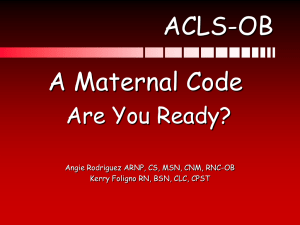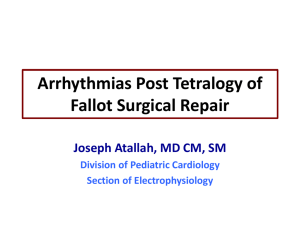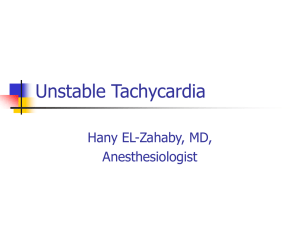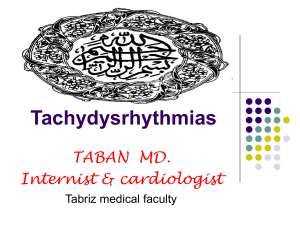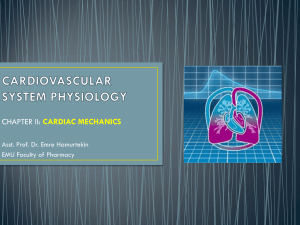2011-6 Yeh YH Grand Round
advertisement
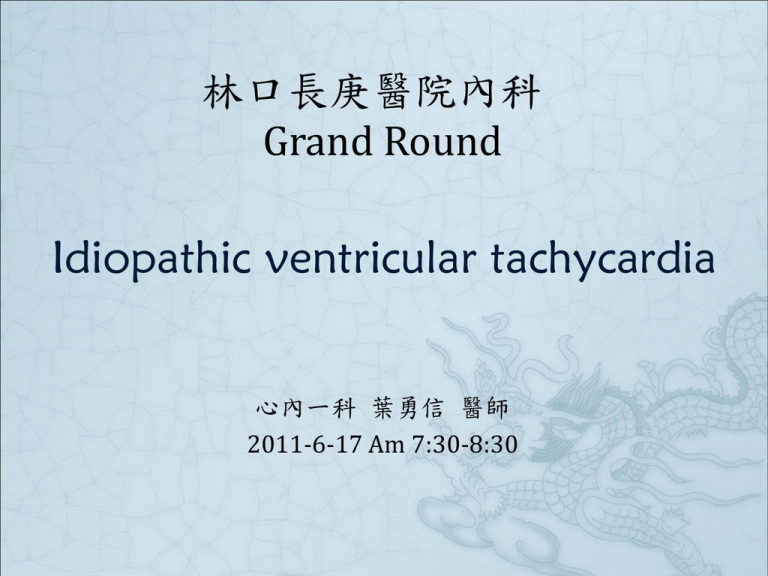
林口長庚醫院內科 Grand Round Idiopathic ventricular tachycardia 心內一科 葉勇信 醫師 2011-6-17 Am 7:30-8:30 Idiopathic Ventricular Tachycardia Ventricular tachycardia that occurs in the absence of clinically apparent structural disease. Clinical evaluation VPC/VT 12-lead ECG morphology Exclude structural heart disease (coronary artery angiography, cardiac echocardiography) No metabolic/electrolyte abnormalities or long QT syndrome can be identified. 24-hour Holter recording Exercise stress test MRI? Holter report Idiopathic Ventricular Tachycardia In 10% of patients with VT Young (20-50 years, range, 6 to 80 years) Palpitation, dizziness, presyncope or syncope (rare) Sudden cardiac death is rare Excellent prognosis Can be a cause of tachycardia-mediated cardiomyopathy Certain anatomic locations with manifest specific ECG patterns which help identify their site of origin. RBBB pattern, superior axis low LV LBBB pattern, inerior axis from RVOT or LVOT Mechanism of tachyarrhythmia (1) Automaticity (2) Triggered activity: Delayed afterdepolarization (DAD) Early afterdepolarization (EAD) Mechanism of tachyarrhythmia (3) Reentry Mechanism of tachyarrhythmia Automaticity 1. focal origin 2. may become incessant during isoproterenol 3. cannot be initiated or terminated by programmed electrical stimulation 4. sometimes suppressed by calcium or β blockers 5. adenosine transiently suppresses but does not terminate it. Triggered activity 1. focal origin RVOT VT: DAD, adensine sensitive 2. EAD or DAD ([Ca2+]i overload due to HR↑, β adrenergic effect (cAMP↑) or digoxin) 3. Induced by burst pacing, isoproterenol infusion or atropine Mechanism of tachyarrhythmia Reentry 1. a large circuit (macroreentry) or focal (microreentry) 2. slow conduction zone: small diastolic potential 3. can be initiated and terminated by programmed electrical stimulation 4. can be entrained from multiple sites Idiopathic left VT: macroreentry, verapamil sensitive Classification of idiopathic VT relative to the mechanism Adenosine-sensitive VT (triggered activity) Propranolol-sensitive VT (automaticity) Verapamil-sensitive VT (reentry) Classification of idiopathic VT relative to the location Outflow tract ventricular tachycardia (OTVT) 1. RVOT VT (90%) above pulmonary valves rarely 2. LVOT VT (10%): above/below AVs, mitral annulus Idiopathic left ventricular tachycardia (ILVT) 1. Left posterior fascicular VT (most common) 2. Left anterior fascicular VT (rare) 3. Upper septal fascicular VT (rare) Others……. Purkinje fibers, epicardium….. RVOT VT 1. 1. Nonsustained, repetitive, monomorphic VT. # Most common form (60-90%) # Characterised by frequent VPCs, couplets and salvos of non sustained ventricular tachycardia (NSVT) # LBBB morphology and inferior QRS axis. # Occurs at rest or following a period of exercise # Transiently suppressed by sinus tachycardia. They may diminish with exercise during stress testing. Paroxysmal, exercise-induced sustained VT. # This VT may be initiated during exercise or recovery. # Exercise stress testing is frequently uses to initiate and evaluate RVOT VT, but is not clinically helpful in most cases. I II III aVR aVL aVF V1 V2 V3 V4 V5 V6 RVOT VT Signal transduction schema for initiation and termination of cAMP-mediated DAD (triggered activity) Adenosine cAMP↓ DAD↓ Outflow tract ventricular tachycardia • • • 90% of outflow tract VT comes from the RVOT - may above the pulmonary valves (rare) 10% may arise from LVOT - superior basal region of LV septum, free wall - aortic sinuses of Valsava - aortic cusps - the aorto-mitral continiuty - mitral annulus - His bundle area Epicardium Management of OTVT 1. 2. Acute termination: vagal maneuver or adenosine (6 mg until 24 mg), IV verapamil (10 mg given over 1 min. These drugs may suppress triggered rhythms; electrical cardioversion. Long term treatment options # Medical therapy: β-blockers, verapamil, diltiazem (efficacy: 20 to 50%); Alternatively class IA, IC and III agents. # Radiofrecuency ablation has cure rates of 90% with a recurrence rate of 5%. Indications for catheter ablation of idiopathic ventricular tachycardia Monomorphic VT that is causing severe symptoms Monomorphic VT when antiarrhythmic drugs are not effective, not tolerated, or not desired Tachycardia-induced cardiomyopathy Contraindication for catheter ablation of idiopathic ventricular tachycardia Presence of a mobile ventricular thrombus Asymptomatic PVCs and/or non-sustained VT that are not suspected of causing or contributing to ventricular dysfunction VT due to transient, reversible causes, such as acute ischemia, hyper-/hypokalemia, or drug-induced torsade de points How to ablate VT Mapping Basic electrophysiologic study Pace mapping (identical 12-lead ECG morphology) Activation mapping (earliest activation site) Electroanatomic mapping (Carto, Navx, Enside Array, Magnetic remote control) (voltage, anatomy) Ablation successful rate: 90 % Mapping Tool for OT-VT ECG morphology: Could be non-inducible Pacing morphology could be large area 2 cm2: different chamber, scar, or epicardium Activation map More accurate: remain unsuccess: more mapping sites, epicardium RVOT VT 1 4 7 2 5 8 3 6 9 Dixit et al, JCE 2003 Dixit et al, JCE 2003 Septum Free wall •↑QRS duration • Notching in inferior lead • Smaller amplitude In inferior lead • Large S wave in V2 > 3 mV • Later QRS transition Dixit et al, JCE 2003 Spontaneous PVC Pace Mapping 1. Important overlapping nature of the outflow tract course! 2. RVOT and PA lie anterior and to the left of the LVOT and aorta. How to D/D RVOT and LVOT VT in origin? LVOT VT Morphology P=0.007 Survival curve of VT patients (N=200) Fascicular VT (ILVT) RVOT ARVC CPVT, idiopathic VF Ischemic VT DCM Management of RVOT VT 1. 2. 3. CAG and 2D echo are usually normal, but MRI may show abnormalities of the RV in up to 70% of patients (focal thinning, diminished systolic wall thickening and abnormal wall motion). RVOT VT should be distinguished from ARVD: ECG morphologic features similar to RVOT VT but DOES NOT terminate with adenosine. It should be strongly considered for the following patients with a potentially malignant form of OT VT: a) a history of syncope; b) very fast VT; c) ventricular premature beats with a short coupling interval. coupling interval Requirement of non-contact mapping system for VT mapping Pacing mapping may not sensitive to locate the sites of foci in certain patients with focal VT, in the presence of large scar area. VT could be non-sustained and unstable. It is difficult to map the entire chamber One beat analysis of dynamic substrate by NCM may be useful to treat these patients. Ensite Array Location RAO LAO RVOT VPC recorded by enside array (Higa S: University of the Ryukyus, Okinawa, Japan) Classification of idiopathic VT relative to the location • Outflow tract tachycardia 1. RVOT VT (most common) 2. LVOT VT • • Idiopathic left ventricular tachycardia (fascicular ventricular tachycardia, intrafascicular verapamil-sensitive VT) 1. Left posterior fascicular VT (most common) 2. Left anterior fascicular VT (rare) 3. Upper septal fascicular VT (rare) Others……. (focal origin in the Purkinje system, triggered activity or automaticity, rare) Fascicular ventricular tachycardia Left posterior fascicular VT (most common) RBBB, superior axis Left anterior fascicular VT (rare) RBBB, right axis deviation, inferior axis Upper septal fascicular VT (rare) A narrow QRS, normal or right axis deviation, inferior axis Posterior Fascicular VT Mechanism of fascicular VT The most likely mechanism of idiopathic left ventricular tachycardia is reentry with an excitable gap and a zone of slow conduction since can be initiated and terminated with programmed stimulation as well as the demonstration of entrainment of the tachycardia with rapid pacing Verapamil sensitive Diastolic potential & Purkinje potential P2 P1=LDP=DP P2=PP P1 P2 Management of fascicular VT The long-term prognosis of patients with fascicular VT without structural heart disease is very good. Arrhythmias in patients with sporadic, welltolerated episodes of idiopathic left ventricular tachycardia may not progress despite absence of pharmacologic therapy. Treated with oral verapamil (120 to 480 mg/day). Ablation successful rate: >95% Posterior Fascicular VT Where to Target Diastolic potential (P1) in the midseptum of LV. P1-QRS=28-130 msec If P1 could not be identified, target the fused and earliest Purkinje potential (P2) Successful ablation revealed P1 during SR could be a marker of successful ablation. Ablation successful rate: >95% Complication: trivial Role of electroanatomic mapping systems Refers to point by point (contact) mapping combined with the ability to display the location of each point in 3-dimensional space. Carto, Navx, Ensite array, Magnetic remote system Functions: 1. non-fluoroscopic localization of the ablation catheter 2. display of intracardiac electrograms (scar, low voltage zone) 3. interpretation of mechanism of arrhythmia (focal or macroreentry) Always useful in scar-related VTs; can be useful in idiopathic VTs. ARVC Classification of idiopathic VT relative to the location, judged by 12-lead ECG morphology Outflow tract tachycardia 1. RVOT VT (most common) 2. LVOT VT: below/above aortic valves, mitral annulus Idiopathic left ventricular tachycardia (fascicular VT) 1. Left posterior fascicular VT (most common) 2. Left anterior fascicular VT (rare) 3. Upper septal fascicular VT (rare) Others……. epicardium, focal origin in the Purkinje system (triggered activity or automaticity, rare) Summary Conclusion Idiopathic VT concerns a small subgroup of patients with VT. Depending on tachycardia mechanism, idiopathic VT may respond to β-blockers, Ca2+ channel blockers or to vagal manueuvers, although radiofrequency ablation is curative in most patients. Patients usually continue to follow up to rule out latent progressive heart disease such as arrhythmogenic right ventricular dysplasia (ARVD) or other forms of cardiomyopathies. Thank you for your attention!

